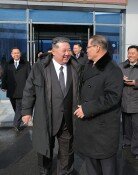What is Behind Korea`s `Employment Mystery?`
What is Behind Korea`s `Employment Mystery?`
Posted July. 15, 2010 14:10,
The Korean job market keeps improving. Despite the halving of the governments job creation target from a year ago, the number of employed shot up to 24.28 million last month, up 314,000 from a year ago and showing a rise in private sector hiring.
Unemployment also remained in the three-percent range for the third straight month. The government said more than 300,000 jobs will be created this year than the last as planned.
Nevertheless, the number of employed aged between 15 and 29 fell last month, raising youth unemployment to 8.3 percent from 5.4 percent in May. Statistics show that employment is rising but that the number of job seekers and discouraged workers is increasing fast.
○ Population as the hidden reason
Youth unemployment reached 10 percent in February this year, the highest since 10.1 percent in February 2000. Last month, the overall jobless rate was 3.5 percent but youth unemployment was much higher at 8.3 percent, indicating that young people benefited little from the improving job situation.
Lee Seo-won, a researcher at LG Economic Research Institute, said Employment of young people tends to decline ahead of others in a recession and increases slowly in recovery. Though the economy continues to recover, companies are tending to hire temporary and daily workers, leading to the worsening of youth employment.
This explanation, however, cannot wholly explain the reason for declining youth employment. Since 2005, youth employment has declined regardless of economic conditions.
The population factor is the hidden reason. The number of those aged 50 or over is increasing fast while that of young people is declining, so youth employment will inevitably decline regardless of job trends.
The Strategy and Finance Ministry said the number of employed youths fell 15,000 in May from a year ago, but will increase 65,000 assuming that the national population increased with all age groups rising at a typical pace.
○ No. of job seekers and discouraged workers up
The number of people studying at private institutes and occupational training centers to prepare for jobs was an average 456,000 per month in 2005, but rose to 642,000 in the first half this year. Last year, the number was lower at 591,000 due to the global economic crisis.
Jeong Yu-hun, a researcher at Hyundai Research Institute, said, When economic conditions get better, the number of job seekers tends to increase along with the employment number. This is because as companies increase hiring, even people who had no desire to find work tend to search for jobs, he said.
The number of highly educated people increased with the university entrance rate rising to 81.9 percent last year from 68 percent in 2000. The better educated seek to get better jobs, a trend which also partly contributed to the increase in job seekers.
Highly educated people also tend to want to work for the company they desire even if it takes several attempts.
The number of discouraged workers had remained steady from 2005 to 2008 but has quickly risen this year. Discouraged workers are those who unsuccessfully tried to find jobs in the past year, and thus have given up their job search.
Eun Sun-hyeon, director of the employment statistics team at Statistics Korea, said, Most people who applied but failed to find work through the governments job creation campaign last year and early this year raised the number of discouraged workers.
In January, 470,000 people applied to get jobs through the governments job creation project, which hired only 100,000 people. Most of the applicants were in their 50s or over, and many gave up searching for a job after they failed. As they gave up looking for work in February and afterwards, they fell into the group of discouraged workers.
lovesong@donga.com hyejin@donga.com







